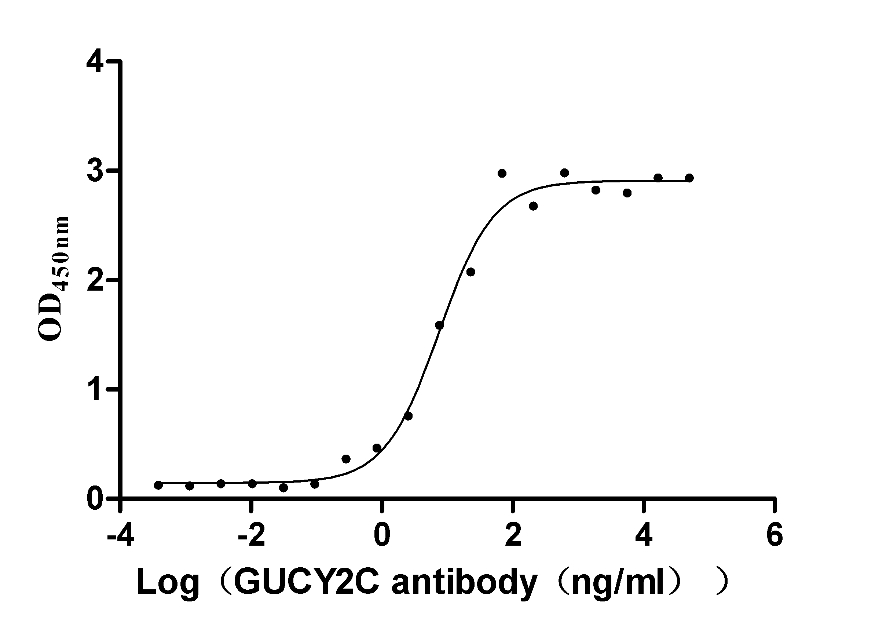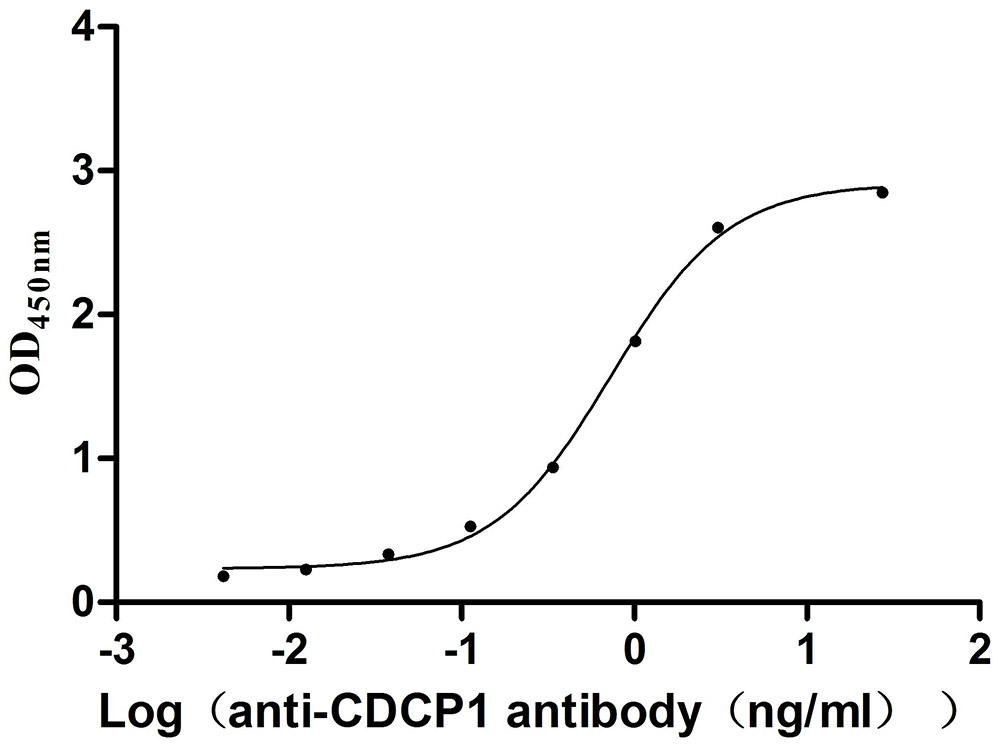Recombinant Mouse Calpain small subunit 1 (Capns1)
-
货号:CSB-YP004503MO
-
规格:
-
来源:Yeast
-
其他:
-
货号:CSB-EP004503MO
-
规格:
-
来源:E.coli
-
其他:
-
货号:CSB-EP004503MO-B
-
规格:
-
来源:E.coli
-
共轭:Avi-tag Biotinylated
E. coli biotin ligase (BirA) is highly specific in covalently attaching biotin to the 15 amino acid AviTag peptide. This recombinant protein was biotinylated in vivo by AviTag-BirA technology, which method is BriA catalyzes amide linkage between the biotin and the specific lysine of the AviTag.
-
其他:
-
货号:CSB-BP004503MO
-
规格:
-
来源:Baculovirus
-
其他:
-
货号:CSB-MP004503MO
-
规格:
-
来源:Mammalian cell
-
其他:
产品详情
-
纯度:>85% (SDS-PAGE)
-
基因名:Capns1
-
Uniprot No.:
-
别名:Capns1; Capn4Calpain small subunit 1; CSS1; Calcium-activated neutral proteinase small subunit; CANP small subunit; Calcium-dependent protease small subunit; CDPS; Calcium-dependent protease small subunit 1; Calpain regulatory subunit
-
种属:Mus musculus (Mouse)
-
蛋白长度:Full length protein
-
表达区域:1-269
-
氨基酸序列MFLVNSFLKG GGGGGGGGGL GGGLGNVLGG LISGAAGGGG GGGGGGMGLG GGGGGGGTAM RILGGVISAI SEAAAQYNPE PPPPRSHYSN IEANESEEVR QFRKLFVQLA GDDMEVSATE LMNILNKVVT RHPDLKTDGF GIDTCRSMVA VMDSDTTGKL GFEEFKYLWN NIKKWQAIYK RFDTDRSGTI GSHELPGAFE AAGFHLNEHL YSMIIRRYAD ESGNMDFDNF ISCLVRLDAM FRAFKSLDKN GTGQIQVNIQ EWLQLTMYS
-
蛋白标签:Tag type will be determined during the manufacturing process.
The tag type will be determined during production process. If you have specified tag type, please tell us and we will develop the specified tag preferentially. -
产品提供形式:Lyophilized powder
Note: We will preferentially ship the format that we have in stock, however, if you have any special requirement for the format, please remark your requirement when placing the order, we will prepare according to your demand. -
复溶:We recommend that this vial be briefly centrifuged prior to opening to bring the contents to the bottom. Please reconstitute protein in deionized sterile water to a concentration of 0.1-1.0 mg/mL.We recommend to add 5-50% of glycerol (final concentration) and aliquot for long-term storage at -20℃/-80℃. Our default final concentration of glycerol is 50%. Customers could use it as reference.
-
储存条件:Store at -20°C/-80°C upon receipt, aliquoting is necessary for mutiple use. Avoid repeated freeze-thaw cycles.
-
保质期:The shelf life is related to many factors, storage state, buffer ingredients, storage temperature and the stability of the protein itself.
Generally, the shelf life of liquid form is 6 months at -20°C/-80°C. The shelf life of lyophilized form is 12 months at -20°C/-80°C. -
货期:Delivery time may differ from different purchasing way or location, please kindly consult your local distributors for specific delivery time.Note: All of our proteins are default shipped with normal blue ice packs, if you request to ship with dry ice, please communicate with us in advance and extra fees will be charged.
-
注意事项:Repeated freezing and thawing is not recommended. Store working aliquots at 4°C for up to one week.
-
Datasheet :Please contact us to get it.
靶点详情
-
功能:Regulatory subunit of the calcium-regulated non-lysosomal thiol-protease which catalyzes limited proteolysis of substrates involved in cytoskeletal remodeling and signal transduction.
-
基因功能参考文献:
- Mitochondrial calpain-1 disrupts ATP synthase, leading to mitochondrial reactive oxygen species generation, which promotes proinflammatory response and myocardial dysfunction during endotoxemia. PMID: 26246018
- Calpain in osteoblasts regulates cell proliferation through its regulation of p27Kip1. Osteoblast-specific capns1 knockout mice developed a high-fat diet-induced excess body weight gain and impaired glucose tolerance. PMID: 22821549
- effects of Capn4 deletion may be mediated through prevention of IkappaB degradation and NF-kappaB activation, resulting in inhibition of inflammatory responses. PMID: 22753411
- Calpain 4 is essential for the tyrosine phosphorylation of galectin-3, and its ultimate secretion from the cell, and its secretion probably interferes with the production of traction forces. PMID: 21640083
- osteoblast-specific Capns1 knockout mice with osteoporosis and reduced bone resorptive function, exhibited reduced serum uncarboxylated osteocalcin levels and a lean phenotype under a normal chow diet. PMID: 21569760
- Calpain 4 is not necessary for LFA-1-mediated adhesion, conjugation or migration. PMID: 20479866
- Data suggest that the calpain small subunit, Capn4, is essential for proper chondrocyte functions in embryonic growth plates. PMID: 20368361
- calpain-mediated endoproteolytic cleavage of PrP(Sc) may be an important event in prion propagation PMID: 15026410
- In calpain-deficient cells, autophagy is impaired with a resulting dramatic increase in apoptotic cell death. PMID: 17101693
- results suggest a regulatory connection between calpain and RhoGDI-1 in promoting formation of membrane blebs PMID: 18076376
- Capn4 in cells of the osteoblast lineage impairs cell proliferation, differentiation, and bone formation PMID: 18515801
- CAPNS1 interferes with PP2A-Akt interaction consequently affecting FoxO3A-dependent cell death. PMID: 19029949
- Capn4 overexpression underlies invasion and metastasis after liver transplantation for hepatocellular carcinoma and may be a candidate biomarker for future diagnosis and a target for therapy. PMID: 19053044
显示更多
收起更多
-
亚细胞定位:Cytoplasm. Cell membrane.
-
数据库链接:
KEGG: mmu:12336
STRING: 10090.ENSMUSP00000001845
UniGene: Mm.439782
Most popular with customers
-
Recombinant Human Heat-stable enterotoxin receptor (GUCY2C), partial (Active)
Express system: Mammalian cell
Species: Homo sapiens (Human)
-
Recombinant Dog B-lymphocyte antigen CD20 (MS4A1)-VLPs (Active)
Express system: Mammalian cell
Species: Canis lupus familiaris (Dog) (Canis familiaris)
-
Recombinant Mouse CUB domain-containing protein 1 (Cdcp1), partial (Active)
Express system: Mammalian cell
Species: Mus musculus (Mouse)
-
Recombinant Human Serotransferrin(TF) (Active)
Express system: Mammalian cell
Species: Homo sapiens (Human)
-
Recombinant Human Interleukin-1 receptor accessory protein (IL1RAP), partial (Active)
Express system: Mammalian cell
Species: Homo sapiens (Human)

















